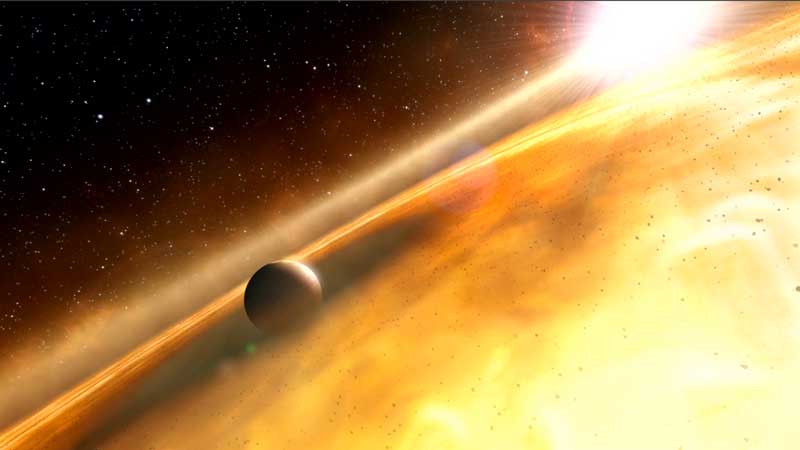Table of Contents

NASA Solar System Ambassador,
Astronomical League Master of Outreach,
Cruise ship speaker on Astronomy & space science,
Amateur astronomer and photographer for 50 years
What is an Exoplanet?

Exoplanets are planets that do not orbit our Sun. Note that they do not have to orbit other stars, because as we will see later, we have also discovered “rogue” exoplanets that are alone in space. As of August 2020, 4301 confirmed exoplanets have been discovered, with another 2120 suspected exoplanets awaiting further confirmation data.
Why is it so difficult to find Exoplanets?
Exoplanets are very small and extremely far away. Compounding this challenge, the ones we are usually most interested in are orbiting their host star closely, so can be lost in the glare. Finally, exoplanets don’t produce any light of their own except through reflection, so are billions of times fainter than their star.
What Methods can be used to find Exoplanets?
Given exoplanets are so small and faint, how can we find them? There are 6 main methods: Transit, Radial Velocity, Microlensing, Direct imaging, Transit Timing Variations, and Pulsar Timing. Let’s take a look at each one.
The Transit Method (3068 discoveries)
By far the most productive way to find exoplanets, the Transit method was used by the Kepler space telescope. If an exoplanet’s orbit aligns with our line of sight, as it crosses the disk of the star it causes a minute, but detectable drop in light from the star.
Advantages: Allows you to determine the size of the exoplanet; most effective and most sensitive method; combined with radial velocity, can deduce mass and density; can check over 100,000 stars simultaneously, atmospheric absorption spectrum tells you about the atmosphere and temperature.
Disadvantages: Exoplanet must orbit roughly in our line of sight (<0.5% of all systems); you must be looking when the transit appears (inefficient for long period exoplanets); usually need several transits to be certain; can get ‘false positives’ from close eclipsing binary stars.
The Radial Velocity Method (888 discoveries)
Also called the Doppler method, this technique uses the fact the light from a star may show a regular redshift followed by a blueshift as the star is pulled slight away from us and then towards us while tugged upon by a planet.
Advantages: this technique works on very distant stars.
Disadvantages: the exoplanet’s orbit must roughly align with our line of sight; it is difficult to detect terrestrial (low mass) exoplanets; can only study 1 star at a time.
Direct Imaging (140 discoveries)
Direct imaging of exoplanets is extremely difficult, because exoplanets are close to their star which is billions of times brighter. Generally speaking, direct imaging is more likely to be successful at infrared wavelengths, because then the star is only about a million times brighter than its planet. This technique relies on methods to block the light from the star.
Advantages: The only known ‘direct’ method; good for finding planets that do not cross stars; good for planets with wide orbits.
Disadvantages: Must be a relatively close host star; planet must be large, and far from the star; can be confused with a brown dwarf star; images are usually blurry.
Microlensing (125 discoveries)
Einstein’s Theory of General Relativity taught us that gravity causes the fabric of spacetime to bend. Gravitational microlensing relies on the gravitational force of distant objects to bend and focus light coming from a star. It requires two stars to be positioned exactly in line with each other and the observer.
Advantages: Good for finding low mass exoplanets; good for very distant exoplanets; can target large areas of the sky simultaneously.
Disadvantages: Can’t be used twice on the same exoplanet; unpredictable; because most findings are very distant, can’t use other methods to verify discoveries.
Transit Timing Variations (43 discoveries)
When there are multiple exoplanets near a star, the gravitational interactions of the planets on each other will cause predictable variations in orbital period. Using this technique we have discovered some stars with at least 7 known exoplanets.
Advantages: Very sensitive method capable of detecting small exoplanets; can determine mass of the exoplanet.
Disadvantages: Difficult to detect exoplanets in distant orbits, exoplanet must orbit roughly in our line of sight.
Pulsar Timing
Pulsars are rapidly rotating neutron stars left behind after a supernova explosion. They emit extremely regular radio waves. A planet in orbit tugs on the pulsar and affects the timing of the pulses. Calculations can then determine the mass and orbit of the exoplanet.
Advantages: Can detect planets as small as 10% Earth’s mass; good for planets far from their star.
Disadvantages: Pulsars are rare; planets that survive the supernova that created the pulsar are rare; such planets are unlikely to support life.
Rogue Exoplanets
A rogue exoplanet is one that has been ejected from the planetary system in which it formed and moves in free space. It is estimated the Milky Way may have billions of rogue planets. Rogue planets are most often discovered via the microlensing technique.
Credit: ESO/P. Delorme/Nick Risinger (skysurvey.org)/R. Saito/VVV Consortium
Density is not Destiny
Many people assume you need to have a small rocky planet in the goldilocks zone to find life. Not so. It’s quite likely there are habitable moons in orbit around gas giants in their goldilocks zone.
We have identified 121 gas giant exoplanets orbiting in the habitable zones of their host stars which might have such moons. In addition, there are probably trillions of exomoons with internal oceans like Europa and Enceladus that may support life.

Credit: NASA GSFC: Jay Friedlander and Britt Griswold
With TESS (the Transiting Exoplanet Survey Satellite), the upcoming launch of the James Webb Space Telescope and other missions, our exoplanet count is expected to increase sharply. Scientists now believe there are trillions of exoplanets in our Milky Way. How many do you think might support life?
References:
- Cover Image: Artist’s impression of the exoplanet, Fomalhaut b, orbiting its sun, Fomalhaut. (Credit: ESA; Hubble, M. Kornmesser; and ESO, L. Calçada and L. L. Christensen)
- https://exoplanets.nasa.gov/alien-worlds/ways-to-find-a-planet/
- http://exoplanet.eu/catalog/

